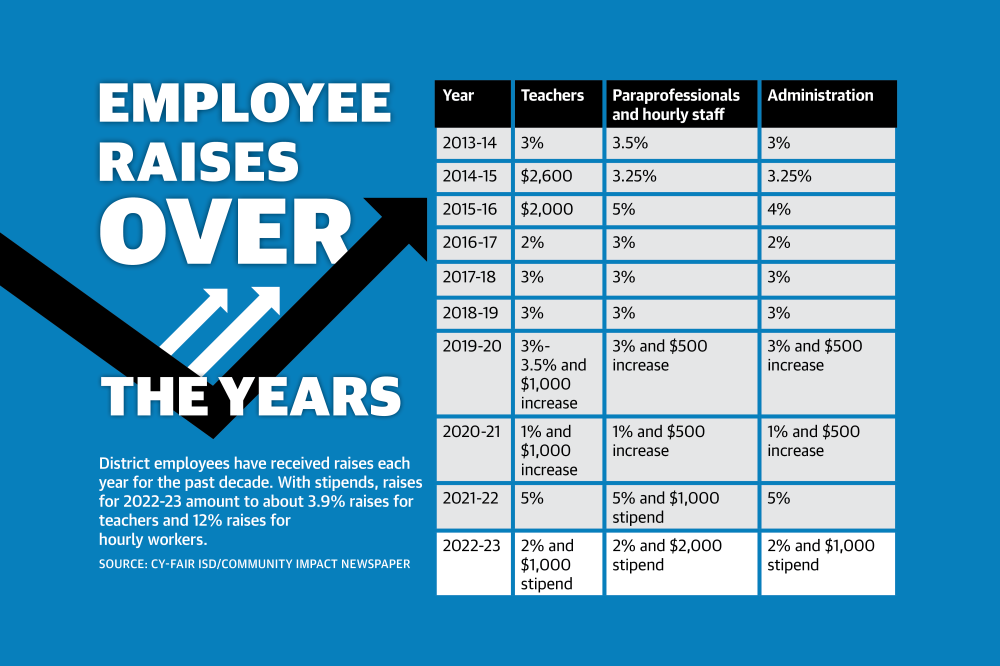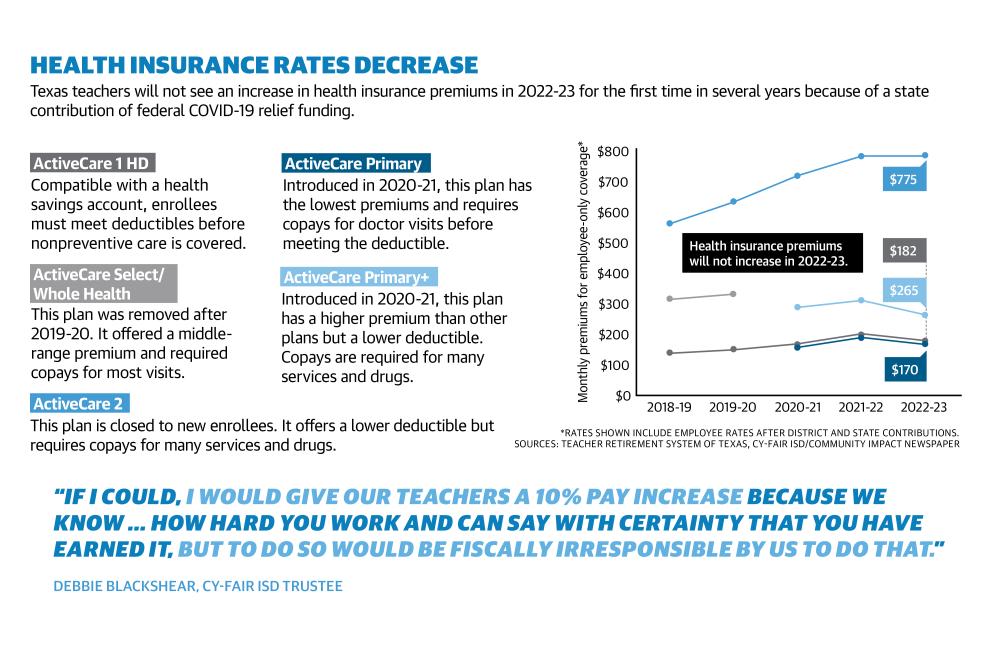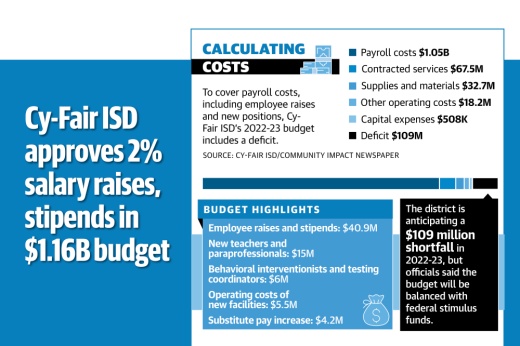All employees will receive a 2% salary increase in 2022-23 along with a recruitment and retention stipend of $1,000 for full-time professionals and a $2,000 stipend for full-time paraprofessionals and hourly workers.
At the June 9 board work session, Trustee Debbie Blackshear said she believes teachers have earned more significant raises, but state funding levels restricted the district.
“If I could, I would give our teachers a 10% pay increase because we know ... how hard you work and can say with certainty that you have earned it, but to do so would be fiscally irresponsible by us to do that,” she said.
The $1.16 billion budget includes a $109 million deficit with state aid making up 40.7% of revenue and local property taxes making up 56.9% of revenue. However, Superintendent Mark Henry said federal stimulus funding is expected to make up the difference for the district to maintain a balanced budget.
Employees received larger raises in 2021-22—5% for all staff plus a $1,000 stipend for hourly employees—but district officials are already preparing for budget cuts in 2023-24 when federal stimulus funding is no longer available.
Chief Financial Officer Karen Smith said as local property tax revenue increases with growing property values, the state decreases its financial support for districts. Other factors influencing the budget included student enrollment, recruitment and retention challenges, and inflation.

Smith called the 2022-23 plans a “transition budget” and urged the community to ask state legislators to increase the per-pupil allotment and to consider the effects of inflation when determining how much funding public schools receive.
“The state is always leveling us back out,” she said. “We basically get a certain amount of revenue per pupil, and as our property values increase, they will decrease our state funding. The only way for a school district to really get additional funding is if your enrollment goes up or your average daily attendance.”
Chandra Villanueva, economic opportunity program director at legislative advocacy nonprofit Every Texan, said state leaders have done little to improve school finance formulas as frustrated teachers look to leave the profession.
“Quite frankly, our school finance system is beyond inadequate to provide a high quality of education, and the Legislature is not making the needed investments that we need to support our teachers in schools,” she said.
Compensating staff
In addition to raises for existing staff, CFISD also increased the starting teacher salary to $60,500 in 2022-23, up from $58,500 in 2021-22. Smith said this move along with across-the-board 2% raises will cost the district about $18.2 million.

According to Smith, neighboring districts of Klein, Tomball and Katy ISDs are CFISD’s main competitors when it comes to staff recruitment. These districts have planned for starting teacher salaries of $60,000, $57,500 and $60,700, respectively, she said.
Nikki Cowart, president of the local teacher’s union Cy-Fair American Federation of Teachers, said she believes while CFISD has satisfactory starting salaries, more experienced teachers have been neglected. The union requested 7% raises, paid bereavement leave days, additional pay for teachers covering other classes and stipends for bilingual employees who serve as translators.
“We know that there are over 20 school districts in Harris County alone, and we’re all vying for the same workforce,” she said ahead of the June 13 budget approval.
When factoring in stipends, hourly workers will see a 12% salary increase on average in 2022-23 while instructional paraprofessionals and teachers will see 11.1% and 3.9% average increases, respectively, according to district data. Executive leadership will see the smallest percentage increase at about 2.6%. The cost of the stipends will be about $22.7 million.
Substitute teachers will see a nearly 20% pay increase from $92 per day to $110 per day, for a total cost of $4.2 million. Another $15 million was set aside to hire additional educators to accommodate district growth.
Chairita Franklin, assistant superintendent of human resources, said while some turnover is typical in CFISD, resignations are up about 20% this year.
“Just like all the school districts across the state, people are leaving the profession and transitioning,” Franklin said.
Meeting additional needs
Following preliminary budget discussions in May, Henry said district leadership met with principals to hear their priorities.
One suggestion that resulted from those conversations was the hiring of a behavioral interventionist or testing coordinator for each elementary and middle school campus based on each school’s needs. It will cost the district about $6 million to fill these 76 roles, which are designed to help with discipline issues and reduce the workload of school counselors, officials said.
Trustee Lucas Scanlon said he believes investing in these new positions will have more value than using that $6 million for larger salary increases.
“When I’ve spoken to teachers, ... the priority that I’ve heard is it’s more about the school culture and the quality of life in the classroom and the ability to deliver their curriculum than it is about the money,” he said.
The board also approved allocating $400,000 to hire six additional district police officers.
This will bring the force to 116 total officers when fully staffed, allowing the department to expand its patrol operations. Police Chief Eric Mendez said while officers are assigned to patrol secondary campuses, there is only one officer available to cover every seven to nine elementary campuses.
“I could use maybe four to six additional officers to cover patrol so that we always have that redundant coverage to ensure that we can respond and handle an incident as it occurs at a campus,” Mendez said.
State support
CFISD leaders and trustees repeatedly expressed disappointment in the Texas Legislature for a lack of adequate funding. Trustee Julie Hinaman said the district has historically used good financial management to end fiscal years with a surplus even when deficits were projected, but that will no longer be the case based on the state’s current funding formulas.
“Unless there are changes made in the next legislative session next year, ISDs will fail financially. It’s set up that way, and it will be that way unless it changes,” she said.
While state aid remains stagnant, district costs continue to increase. Without federal stimulus funding beyond 2022-23, CFISD’s fund balance is expected to dwindle. Budget cuts are more likely than salary increases in 2023-24, officials said.
“There is no mechanism in place at the state level to account for inflation, so when you have a year where inflation is going up like it has the last couple of years, there is no adjustment to the basic allotment, which is what allows us to function,” Henry said in May.
Villanueva said since the state’s basic allotment is not based on the actual cost of public education, Every Texan has advocated for a cost-based analysis or for the state to adjust the basic allotment for inflation each year.
Hinaman said there is no shortage of money for teacher raises, school safety, closing learning gaps and mental health care, but the state government is holding onto those funds. She noted Texas expects to have $15 billion in its Economic Stabilization Fund in addition to a $12 billion-$15 billion surplus in the state budget at the start of the next legislative session in 2023.

However, state leadership did announce some relief to public school employees in April when Gov. Greg Abbott committed $435 million in federal COVID-19 relief funds to ensure health insurance premiums do not increase in 2022-23 for those enrolled in the Teacher Retirement System of Texas’ health insurance program.
Most CFISD enrollees will pay about $22-$75 less each month for health care coverage depending on their plan, according to district documents. According to Cowart, past salary increases have mostly gone toward year-over-year insurance premium increases.
“If we discuss [TRS-ActiveCare] premiums that are not increasing the next school year, we should have certainly included all the years it did increase and consume much of the pay raise dollars of the past,” Cowart said.






